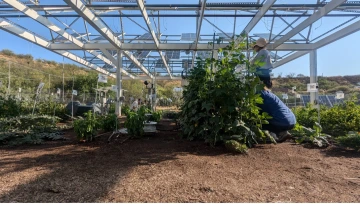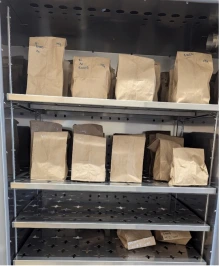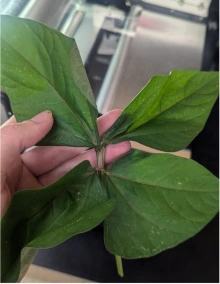Exploring Crop Nutrients in Agrivoltaic Systems

Figure 1: The SALSA agrivoltaic research site at Biosphere 2, Arizona
As climate change continues to reduce water availability and increase temperatures globally, researchers and farmers are exploring innovative solutions that allow us to maintain crop production under increasingly extreme climates. One promising approach is agrivoltaics, which combines agriculture with solar electricity production by growing crops in the shade of solar panels. In the decade since the term 'agrivoltaics' was coined, research has answered many initial questions about these systems' viability. However, important questions remain unanswered – particularly regarding how the agrivoltaic growing environment might affect crop nutrient composition. As agrivoltaic systems become more widespread globally and increasing numbers of farmers turn to them as a potential solution, understanding their impact on crop quality grows increasingly crucial. As part of my PhD research, and with support from the Center for Regional Food Studies Student Award, we set out this summer to investigate this unanswered question.

Figure 2: The crops we tested for changes in nutrient content growing underneath our agrivoltaic system
The search for answers began at Biosphere 2 in Arizona, one of the research sites where our lab group, SALSA (Semi-Arid Lab for Scalable Agrivoltaics), studies the complex interactions between solar panels and crop production. Both the previous work of our lab group and others has shown how agrivoltaic systems can create unique growing environments that significantly benefit crop production, particularly in harsh climates like Arizona's. These systems demonstrate several key benefits: they can increase soil moisture retention, allowing the soil to stay wetter for longer periods and providing crops with extended access to water; they can create a beneficial microclimate by reducing both air and soil temperatures, protecting crops from extreme heat; and they can decrease direct sunlight exposure, reducing light stress that crops typically experience during the intense Arizona summer.

Figure 3: Samples being dried in our oven
These modified environmental conditions don't just affect plant growth – they can also have significant effects on soil chemistry and nutrient dynamics. The altered soil moisture levels and temperatures can influence both nutrient availability in the soil and the rate at which plants absorb these nutrients. This interplay between environmental conditions and nutrient uptake led us to hypothesize that crops grown in agrivoltaic systems might show differences in their nutrient content compared to those grown in traditional agricultural settings. To test this hypothesis, we selected two commonly cultivated crops: cowpea and basil. These plants were chosen not only for their widespread cultivation but also for their importance in both commercial agriculture and many local food systems. We designed our experiment to compare plants grown in full sunlight against those grown under solar panels, focusing on inorganic nutrients, such as iron and magnesium, to understand how the modified environment affects the nutrient content of different crops.

Figure 4: One of the cowpea samples we analyzed
To do this we collected fresh plant samples from both growing conditions and transported them back to our lab where they were cleaned of any other material, such as soil, to ensure only plant material was included – after all, we are interested in what’s in the leaf, not what’s on it. The samples were then weighed, and the leaf area was measured. They were then dried, removing all moisture and re-weighed to determine how much water each leaf sample had held. The dried samples were then ground to a fine powder and analyzed using a technique called inductively coupled plasma which allows us to identify and measure the amount of different nutrients present in each sample.
This kind of analysis isn’t cheap, and this is where the Center for Regional Food Studies Student Award made a difference. Their support allowed us to analyze more samples, helping us build a more complete picture of how the agrivoltaic growing environment affects nutrient levels in our crops.
While we’re still in the midst of analyzing our results, the data we have gathered so far has brought us much closer to understanding if agrivoltaics do impact crop nutrient content. Looking ahead, our findings will help us inform farmers and policymakers about how best to implement these systems. Thanks to the support we've received, we're one step closer to ensuring that agrivoltaic systems can deliver on their promise: helping us grow sustainable, nutritious food in a changing climate.

